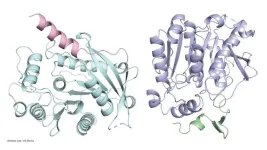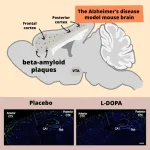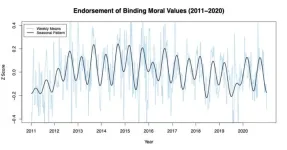(Press-News.org) Social media’s rise to popularity between 2010 and 2020 has been strongly correlated with the nationwide freefall in youth mental health that characterized the 2010s. Lawmakers have put increasing pressure on the U.S. government to take social media regulation more seriously, with cases about platforms like Facebook, Instagram and X rising to the Supreme Court level.
But despite the ubiquity of social media, scientists at Northwestern Medicine and Ann & Robert H. Lurie Children’s Hospital of Chicago found that in Illinois, youth emergency room visits and hospitalizations for depression and anxiety decreased after the COVID-19 shutdown and have plateaued at lower, pre-2016 rates.
“We wanted to see if COVID exacerbated the problem or changed it in any way,” said Northwestern’s Joe Feinglass, the study’s lead author. “And the answer was somewhat to our surprise that COVID actually reduced the number of emergency room visits, which was expected during the shutdown but was sustained into 2023.”
The study, published Aug. 5 in The American Journal of Emergency Medicine, analyzed all ER visits and admissions from Illinois youth with a coded primary diagnosis of depression and anxiety from January 2016 to June 2023, collecting data from 232 hospitals across the state. The authors offered speculation on what caused the spike, then the sustained decline, in youth ER visits — though not inpatient psychiatric hospitalizations — during the study period.
Feinglass said while he initially was uncertain about factors that correlated to his findings, over time he has become convinced that social media use is by far the “most credible” reason for the 2010’s surge in ER visits and hospitalizations for depression and anxiety. Feinglass is a research professor of medicine at Northwestern University Feinberg School of Medicine.
“Social media is something that affects teens’ lives and young people's lives in a day-to-day, hour-to-hour way,” Feinglass said. “The number of teenagers that had a smartphone in 2012 was around 5%. By the time we're done with this period, 85% have a smartphone. The number of hours of sleep goes down, the interactions with other people go down. So to the extent that you're on these screens, your screen time kills your ability to have actual social interaction.”
The drop in ER visits since the pandemic shutdown could indicate that youth have hit a ceiling in their social media use, causing a plateau in ER visits and admission rates, he said, adding the use of smart phones may have created new forms of otherwise impossible in-person socialization through video chat technology.
Though there was considerable fear that school shutdowns could exacerbate poor mental health, staying home with families for the first year and subsequent anecdotal reports from teachers imply that school may have gotten easier, which may have reduced what teens report as their number one stressor.
The study also assessed patients based on zip code, gathering localized data about the percent of residents living in poverty. Data show the decrease in visits was smaller for girls than boys, greater in areas with lower incomes and for visits to smaller community hospitals.
Outpatient ER visits for depression and anxiety, in which patients are sent home rather than being admitted to the hospital, declined the most sharply, with in-patient hospitalization rates remaining constant across the study timeline — something the authors say may be owed to the fixed number of psychiatric hospital beds available to young mental health patients.
In-patient hospitalization rates, however, indicate the youth mental health epidemic is continuing, said Feinglass, but the current stable rate of visits may just reflect a saturation point of youth social media use.
“COVID may have led to improvement and innovations in mental health services,” Feinglass said. “With telehealth, there’s been a huge increase in the amount of counseling that’s available online and by phone. Mental health hotlines are also more readily available.”
The authors say just increasing the number of psychiatric beds or therapists is insufficient, and instead, changing social and cultural conditions upstream are needed to shift the epidemic’s trajectory. Senior author and Lurie Children’s attending physician Audrey Brewer added that updated pediatric primary care practices, including mental health screenings, can ensure children receive intervention for mental health challenges before they reach a crisis point.
“We need a better understanding of how to move youth mental health care away from emergent hospital care to more effective home and office settings,” Brewer said. “There is also an ongoing debate about how best to restrict addictive cell phone and social media use by children and teens.”
END
Youth mental health-related emergency room trips declined significantly after Illinois ended COVID-19 lockdown
Social media ‘saturation point,’ advancements in telehealth could be behind the drop
2024-08-06
ELSE PRESS RELEASES FROM THIS DATE:
How plants become bushy, or not
2024-08-06
or many plants, more branches means more fruit. But what causes a plant to grow branches? New research from the University of California, Davis shows how plants break down the hormone strigolactone, which suppresses branching, to become more “bushy.” Understanding how strigolactone is regulated could have big implications for many crop plants.
The study was published August 1 in Nature Communications.
“Being able to manipulate strigolactone could also have implications beyond plant architecture, including on a plant’s resilience to drought and pathogens,” said senior author Nitzan Shabek, an associate professor in the UC Davis Department of ...
Research spotlight: Identifying potential new protein targets for melanoma therapeutics
2024-08-06
How would you summarize your study for a lay audience?
Some proteins, such as programmed cell death protein 1 (PD1), can stop the immune system from attacking cancer cells and, therefore, support the growth of cancer. Therapies targeting these proteins can be highly effective, but tumors can become resistant.
We applied a method to detect proteins on a single–cell level to uncover human carcinoembryonic antigen cell adhesion molecule 1 (CEACAM1) patterns in melanoma. We found that increased ...
Damon Runyon Cancer Research Foundation awards $5.2 million to top clinical investigators
2024-08-06
Damon Runyon Cancer Research Foundation awards $5.2 million to top clinical investigators
The Damon Runyon Cancer Research Foundation has named six new Damon Runyon Clinical Investigators. The recipients of this prestigious award are outstanding, early-career physician-scientists conducting patient-oriented cancer research at major research centers under the mentorship of the nation's leading scientists and clinicians.
The Clinical Investigator Award program was designed to increase the number of physicians capable of translating scientific discoveries into new treatments for cancer patients. Each Awardee will receive $600,000 over three years, ...
Good outcomes 10 years after surgery for ectopic bone in thoracic spine
2024-08-06
August 6, 2024 — Thoracic ossification of the posterior longitudinal ligament (TOPLL) is a rare condition associated with ectopic bone formation in the thoracic spine. A long-term follow-up study from Japan shows significant and lasting improvement in outcomes with posterior decompression and fixation surgery for patients with T-OPLL, reports The Journal of Bone & Joint Surgery. The journal is published in the Lippincott portfolio by Wolters Kluwer.
"Surgical treatment of T-OPLL is effective in improving neurological function, quality ...
Dopamine treatment alleviates symptoms in Alzheimer’s disease
2024-08-06
A new way to combat Alzheimer’s disease has been discovered by Takaomi Saido and his team at the RIKEN Center for Brain Science (CBS) in Japan. Using mice with the disease, the researchers found that treatment with dopamine could alleviate physical symptoms in the brain as well as improve memory. Published in the scientific journal Science Signaling on August 6, the study examines dopamine’s role in promoting the production of neprilysin, an enzyme that can break down the harmful plaques in the brain that are the ...
Do your supplements contain potentially hepatoxic botanicals?
2024-08-06
Millions of Americans consume supplements that contain potentially hepatoxic botanical ingredients, according to a study from University of Michigan researchers.
Over a 30-day period, 4.7% of the adults surveyed in the National Health and Nutrition Examination Survey conducted from 2017 to 2020 took herbal and dietary supplements containing at least one of the botanicals of interest: turmeric; green tea; ashwagandha; black cohosh; garcinia cambogia; and red yeast rice containing products.
The resulting paper, “Estimated Exposure ...
No room for nuance in polarized political climate: SFU study
2024-08-06
Sometimes you just can’t win, and that goes double for people navigating the increasingly polarized political landscape in the United States.
Having nuanced opinions of politics in the U.S. turns out to be a very lonely, and unpopular, road, according to a recent study from a research team that includes assistant professor Aviva Phillipp-Muller from Simon Fraser University’s Beedie School of Business.
Published in the Journal of Experimental Social Psychology, the study found that people who express ambivalence about political topics – ranging from COVID-19 mask mandates, immigration and the death ...
What happens to your brain when you drink with friends?
2024-08-06
EL PASO, Texas (Aug. 6, 2024) – Grab a drink with friends at happy hour and you’re likely to feel chatty, friendly and upbeat. But grab a drink alone and you may experience feelings of depression. Researchers think they now know why this happens.
“Social settings influence how individuals react to alcohol, yet there is no mechanistic study on how and why this occurs,” said Kyung-An Han, Ph.D., a biologist at The University of Texas at El Paso who uses fruit flies to study alcoholism.
Now, Han and a team of UTEP faculty and students have taken a key step in understanding the neurobiological process behind social drinking and how it boosts ...
University of Houston researchers create new treatment and vaccine for flu and various coronaviruses
2024-08-06
A team of researchers, led by the University of Houston, has discovered two new ways of preventing and treating respiratory viruses. In back-to-back papers in Nature Communications, the team - from the lab of Navin Varadarajan, M.D. Anderson Professor of William A. Brookshire Chemical and Biomolecular Engineering - reports the development and validation of NanoSTING, a nasal spray, as a broad-spectrum immune activator for controlling infection against multiple respiratory viruses; and the development of NanoSTING-SN, a pan-coronavirus nasal vaccine, that can protect against infection and disease by all members of the coronavirus family.
NanoSTING ...
People's moral values change with the seasons
2024-08-06
A new UBC study has revealed regular seasonal shifts in people’s moral values.
The finding has potential implications for politics, law and health—including the timing of elections and court cases, as well as public response to a health crisis.
The research published this week in Proceedings of the National Academy of Sciences (PNAS) analyzed survey responses from more than 230,000 people in the U.S. over 10 years and revealed that people’s embrace of certain moral ...
LAST 30 PRESS RELEASES:
There are new antivirals being tested for herpesviruses. Scientists now know how they work
CDI scientist, colleagues author review of global burden of fungus Candida auris
How does stroke influence speech comprehension?
B cells transiently unlock their plasticity, risking lymphoma development
Advanced AI dodel predicts spoken language outcomes in deaf children after cochlear implants
Multimodal imaging-based cerebral blood flow prediction model development in simulated microgravity
Accelerated streaming subgraph matching framework is faster, more robust, and scalable
Gestational diabetes rose every year in the US since 2016
OHSU researchers find breast cancer drug boosts leukemia treatment
Fear and medical misinformation regarding risk of progression or recurrence among patients with breast cancer
Glucagonlike peptide-1 receptor agonists and asthma risk in adolescents with obesity
Reviving dormant immunity: Millimeter waves reprogram the immunosuppressive microenvironment to potentiate immunotherapy without obvious side effects
Safety decision-making for autonomous vehicles integrating passenger physiological states by fNIRS
Fires could emit more air pollution than previously estimated
A new way to map how cells choose their fate
Numbers in our sights affect how we perceive space
SIMJ announces global collaborative book project in commemoration of its 75th anniversary
Air pollution exposure and birth weight
Obstructive sleep apnea risk and mental health conditions among older adults
How talking slows eye movements behind the wheel
The Ceramic Society of Japan’s Oxoate Ceramics Research Association launches new international book project
Heart-brain connection: international study reveals the role of the vagus nerve in keeping the heart young
Researchers identify Rb1 as a predictive biomarker for a new therapeutic strategy in some breast cancers
Survey reveals ethical gaps slowing AI adoption in pediatric surgery
Stimulant ADHD medications work differently than thought
AI overestimates how smart people are, according to HSE economists
HSE researchers create genome-wide map of quadruplexes
Scientists boost cell "powerhouses" to burn more calories
Automatic label checking: The missing step in making reliable medical AI
Low daily alcohol intake linked to 50% heightened mouth cancer risk in India
[Press-News.org] Youth mental health-related emergency room trips declined significantly after Illinois ended COVID-19 lockdownSocial media ‘saturation point,’ advancements in telehealth could be behind the drop




